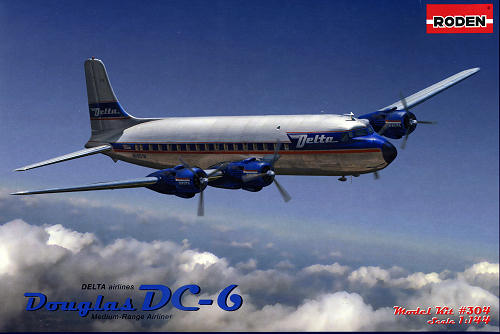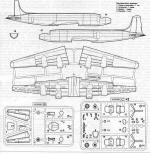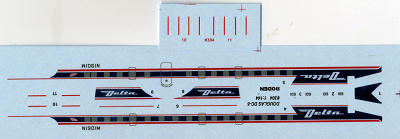
| KIT #: | 304 |
| PRICE: | $32.9916.98 |
| DECALS: | One option |
| REVIEWER: | Scott Van Aken |
| NOTES: |

| HISTORY |
| THE KIT |
 Molded
in grey plastic on four sprues with separate fuselage halves and a separate
clear piece for the cockpit transparencies, this one is quite similar to the
earlier DC-7 in terms of its molding. It looks a lot like the Minicraft kit that
I built a while back, but perhaps there are only so many ways to mold an
airplane like this.
Molded
in grey plastic on four sprues with separate fuselage halves and a separate
clear piece for the cockpit transparencies, this one is quite similar to the
earlier DC-7 in terms of its molding. It looks a lot like the Minicraft kit that
I built a while back, but perhaps there are only so many ways to mold an
airplane like this.
One thing I did notice was an inconsistency in the engraved detailing. For instance, the under wing inspection panels were not the same from one side to the other. I also noticed that a few of the engraved lines got lighter then heavier during a long run. Detailing in the separate engine faces is good for this scale. For the cockpit there is only a floor and bulkhead with no seats. Since the fuselage is a blank (as in no window openings), many modelers will probably just paint the cockpit windows from the inside.
I noticed that, unlike Minicraft and F-RSIN, the main landing gear doors appear
to be properly molded so that those who wish to close them, can do so without
all the fuss I had with the two aforementioned kits. Prop blades are also done
fairly well. The instructions recommend 10 grams of nose weight to keep it from
tail sitting. They also suggest trimming the nose gear retraction strut. An
interesting addition is two different nose cones. One is blunt as on the DC-6A
while the other is sharper as you would
 find on the
DC-6B/C-118.
find on the
DC-6B/C-118.
Instructions are well drawn with color information as needed and with Model Master paint references. The overall markings scheme is in full color for Delta Airlines "in the early 1950th" (sic). As nicely printed as the kit decals are, my experience with Roden decals has not been good so I would recommend an aftermarket replacement.
| CONCLUSIONS |
A nice addition to the Roden line of Airliners. One would hope that they continue doing these sorts of kits. I am a big fan of propliners and would love to see a nicely done Bristol Britannia, for example.
| REFERENCES |
http://en.wikipedia.org/wiki/Douglas_DC-6
November 2011 Thanks to Squadron Products for the
preview kit. If you would like your product reviewed fairly and fairly quickly, please contact the editor or see other details in the
Note to
Contributors.